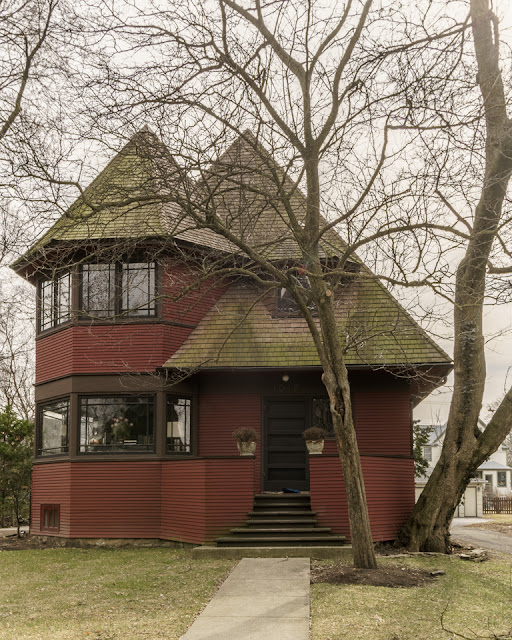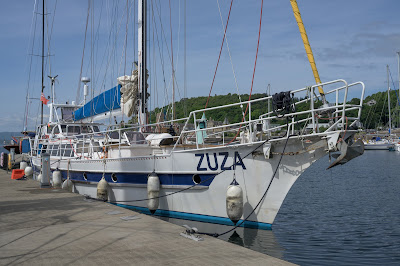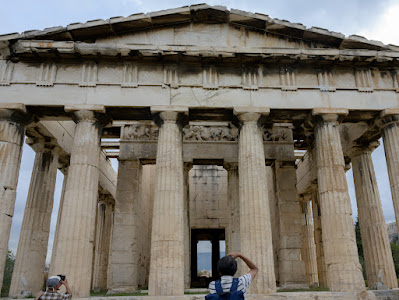As I mentioned in my last blog, Wright had lost his job with Adler and Sullivan because he had been designing his 'bootleg' houses on the side, to earn himself some extra cash. After viewing his home and studio in Oak Park we had a short tour of the neighbourhood houses that he had created. The three 'bootleg' houses are within easy reach of Wright's studio, one being directly over the road from him.
 |
| Robert P Parker House, 1892 |
 |
| Thomas Gale House, 1892 |
 |
| Walter Gale House, 1892 |
 |
| Walter Gale house in front, next to Thomas Gale House |
Walter Gale owned a hardware store in Chicago. Thomas Gale was a speculator and had his house and the Robert Parker house built by Wright. Thomas Gale sold the Parker House to Robert Parker, a lawyer, a year later. All three houses look similar, with their large bays, This was a style favoured by Joseph Silsbee, Wright's first employer.
Wright liked to be thought of as a 'man about town' and would be seen sporting a broad brimmed hat, a red-lined cape and a cane. He was also a bit of a womaniser. He and his wife Kitty had six children but in spite of this and the home he had built, Wright, at the age of 42 fell in love with Mama Cheney, the wife of a client.
The couple eloped to Europe but returned a year later and Wright began to build what a local paper called a 'love bungalow' in Wisconsin, on 600 acres of land owned by his mother's family. This house, known as Taliesin was to be one of Wright's greatest achievements. Sitting against the hills it fulfilled Wright's ideas of a meld of building and nature. "No house should ever be on a hill, or on anything. It should be of the hill. Belonging to it. Hill and house should live together, each the happier for the other".
But in August 1914, while Wright was working in Chicago the unimaginable happened. Mamah had sat down to lunch with her two children and some workers from the Taliesin estate, when Julian Carlton, a servant who had been threatened with the sack locked all the doors, doused everything with petrol and set light to the house. He then killed seven of the occupants, including Mamah and her children, with a hatchet. He survived the fire but drank acid and died a week later in custody.
Wright was distraught but wasted no time in commencing to rebuild Taliesin, making it more elaborate than before. He then spent 10 years in Tokyo building the luxurious Tokyo hotel. On coming back to Chicago he found it difficult to get work. Fashion had moved on and Le Corbusier was the 'in' architect.
By 1923 he was divorced from Kitty and married to Miriam Noel, a rather hippy clairvoyant. The marriage did not last long, they fought and Miriam's behaviour became more erratic. She was later found to be a morphine addict.
Wright's assistants lived in Taliesin and the freestyle community grew their own vegetables and made music together in the evenings. To this household came Olgivanna Hinzenberg, a dancer from Montenegro with one daughter, who was separated from her husband. She quickly became pregnant with Wright's child. While she was in hospital, having just had the baby, Wright's second wife Miriam burst into her room demanding to see "my husband's baby". She then tried to have Wright arrested under the Mann Act, which was formulated to stop the illegal trafficking of foreign prostitutes!
In 1925, just before the birth of the baby, Taliesin was again hit by fire, this time through an electrical fault. The house was burnt to the ground and Wright lost his collection of paintings worth around half a million dollars. Needless to say the insurance did not cover all of the damage.
However Wright picked himself up again, rebuilt the house and in 1928 married Olgivanna. They decided to invite paying students to live with them in Taliesin and study under Wright, following his holistic way of working. These students were expected to cultivate the land, do household chores and spend musical evenings with Wright, listening to him playing Bach and Beethoven on his grand Steinway piano. Wright's vanity was legendary and on being questioned about it said "Early in life I had to choose between honest arrogance and hypocritical humility. I chose honest arrogance."
At first Wright spent time just teaching but in the latter part of this period Wright designed some of his most famous buildings, including Falling Water, built dramatically over a waterfall, for the father of one of his students. His reputation as an architect was in the ascendence again and in 1937 he built Taliesin West in Arizona, a winter home for his family and students. Designed in an open plan manner the house was the backdrop for the community ethos, based on the teachings of George Gurdjieff, an Armenian guru who Oligivanna had lived and studied with before she met Wright. These ideas encouraged creativity and also involved a lot of dancing, allowing for a good deal of satire from Wright's detractors.
In the last 25 years of his life Wright was extremely active and designed many important building including the Guggenheim in New York. He died in 1959 having created over 500 buildings.
He went out of fashion for many years, but now with the emphasis on energy efficient, low impact buildings using local materials, his style has again achieved popularity.
The main source for this material is an article written for the Independent by Marcus Field in 2009, on the occasion of the exhumation of Wright's ashes from a grave in Wisconsin to be moved to a Taliesin West and mixed with those of his wife Olgivanna before reburial there.
http://www.independent.co.uk/arts-entertainment/architecture/architect-of-desire-frank-lloyd-wrights-private-life-was-even-more-unforgettable-than-his-buildings-1637537.html
So, back to the houses. In Oak Park you can see the development of Wright's Prairie style of house where rounded corners are replaced by sharp angles.
I will picture the houses in chronological order. The Unity Temple building was designed in 1905. It is under restoration at the moment and unfortunately surrounded by detritus and orange plastic fencing.
This is by no means all the houses Wright created in Oak Park. In all he built 25 between 1889 and 1913.
 |
| Francis J Wooly House, 1893 |
 |
| Nathan J Moore House, partially destroyed by fire in 1922 Rebuilt and redesigned by Wright in 1923 |
 |
| William Fricke House, 1901 |
 |
| Frank Thomas House, 1901 |
 |
| Arthur Heurtley House, 1902 |
 |
| Unity Temple, 1905 |
 |
| Peter Beachey House, 1906 |
 |
| Laura Gale House, 1906 |
























Comments
Post a Comment